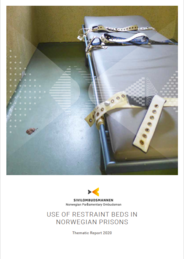The use of restraints in prison in order to prevent inmates from harming themselves or attempting suicide, raises important human rights and health-related questions. The revision of 82 decisions, alongside experience and the data collected from visits to several prisons, identified the following main issues:
Risk to Life and Health
The use of restraints involves a risk of both somatic injuries, including fatal injuries, as well as a risk of trauma and serious psychological distress. Despite this, in most of the cases where restraint beds were used, they were used with minimal supervision by medical personnel. Qualified medical personnel are generally neither present at the start of nor during the time spent in re traints. Inmates placed in restraints do not receive medical assistance from the specialist health service, but from the local accident and emergency unit or from the prison health service. Doctors from the accident and emergency unit do not have expertise in the use of restraints, and the review of the prison health service’s procedures revealed major shortcomings. On a national level, restraint beds were only used on an average of 15 times per year. This entails a risk that prison officers with little or no previous experience with restraints must use this highly intrusive measure on inmates in acute psychological crisis.
Discrimination
The use of restraints to prevent people from harming themselves is a contentious issue. The UN Special Rapporteur against Torture has stated that persons with mental illnesses should not be s ubjected to such forms of coercion. The Parliamentary Ombudsman has in several visit reports and in the Special Report to the Storting on Solitary Confinement and Lack of Human Contact in Norwegian Prisons, pointed out that solitary confinement in prison can increase the risk of suicide, self-harm and development of serious mental disorders. Several of the cases where restraint beds were used seemed to result from precisely such a sequence of events; where suicidal inmates had been placed in solitary confinement and started to self-harm in the security cell. People who are suicidal or have inflicted serious self-harm need medical assistance. If restraint beds in practice become a measure that prevents inmates from getting the medical assistance they require, the use of restraint beds can constitute discrimination and a violation of the inmates’ right to receive medical assistance. The fact that women are at a higher risk of being placed in restraints than men, and that they are more often put in restraints several times, raises additional questions about discrimination. Inmates placed in restraints do not receive medical assistance from the specialist health service, but from the local accident and emergency unit or from the prison health service. Doctors from the accident and emergency unit do not have expertise in the use of restraints, and the review of the prison health service’s procedures revealed major shortcomings.
Lack of Legal Safeguards
Although the use of restraint beds is one of the most intrusive measures a prison can use, the quality of the decisions and supervision logs show significant shortcomings in the legal safeguards for those concerned. A large number of decisions do not explain why the measure was deemed strictly necessary, or document why the decision should be upheld, and there is no documentation stating that less intrusive measures have been attempted. These extensive shortcomings prevent a real possibility to file a compl int and raise major issues in
relation to internal oversight. Many of the factors indicate a violation of the prohibition against inhuman treatment, set out in the UN Convention against Torture and the ECtHR Article 3 as interpreted by the European Court of Human Rights.
Source: Norwegian Parliamentary Ombudsman

